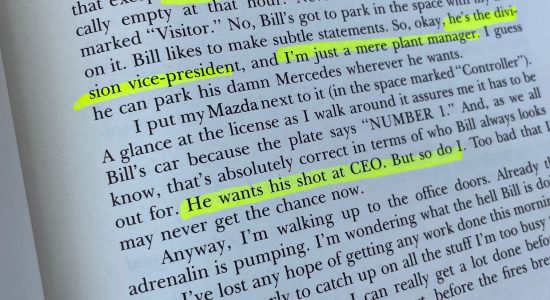The Goal by Eliyahu M. Goldratt and Jeff Cox (1984)
Will a book based on process and minimizing overhead stay relevant or just serve as source material living in the hall of fame as the grandpappy to strategies we use now. Well we will find out soon.
In Chapter 1 we are introduced to two main characters:
Alex Rogo – Plant Manager
Bill Peach – Division VP

Right out the gate there is a clear emphasis to show the power dynamics in the company. We also learn that Rogo is showing signs of stress due to the narrative given of slights at every direction. Think about it, Bill Peach drives a nice car. He parks in Rogo’s parking spot. He overrules his decision making, he sits in Rogo’s seat, and also gives him a three month ultimatum to change the company’s work process.
And he wears sunglasses at night.
Ok I added that last part, but you get the picture, the struggle between Rogo and Peach is real. And it’s only page #1.
It is pretty clear that Goldratt wants to show that Alex Rogo is not only going to learn about management processes throughout the book related to workflow, but that there is an upcoming crash course of resolving culture issue at the plant in store for us too. The book is one part MBA framework, with a sweet splash of communication improvement.
There are also sub plots developing in chapter 1. There is a machine that runs everything important in the plant, that can stop all of production if someone doesn’t use the correct screwdriver during repairs. In a tone similar to that used by the Phoenix Project, it just seems at a high level that no one at the plant really likes anybody else, and all are walking on eggshells.
So the foundation is set, and The Goal begins. One of the purposes of the book is to show that the change process can improve even within a tight time frame of three months, if the constraints are identified and addressed. It will be an interesting journey.
The question I posed at the end of chapter 1 is below:
“Notice Bill Peach comes in early in the morning inspired to spark action and motivate the troops. However, he does not evaluate or ask questions related to the problem. At what point is firefighting part of the problem and not part of the solution?”
